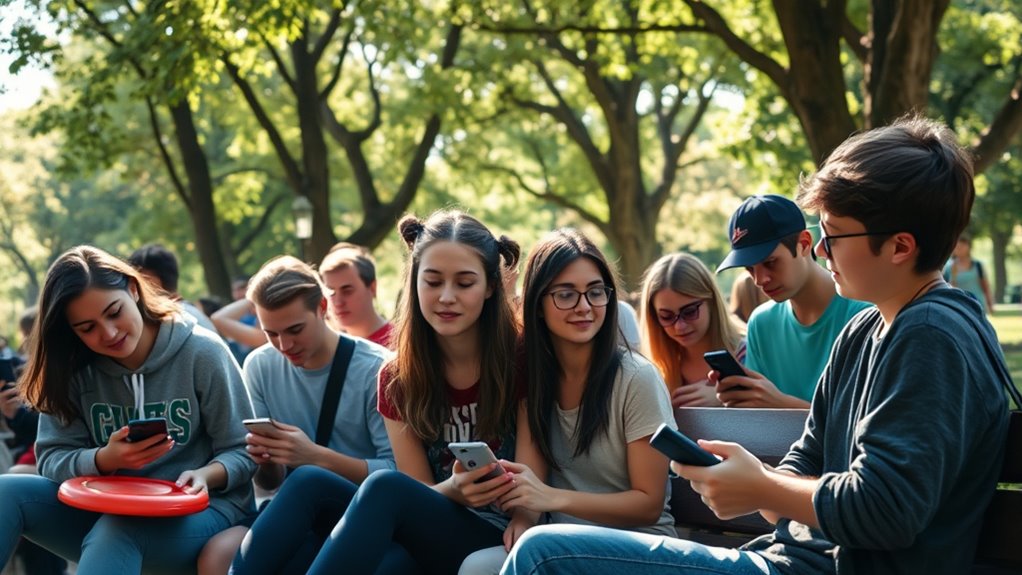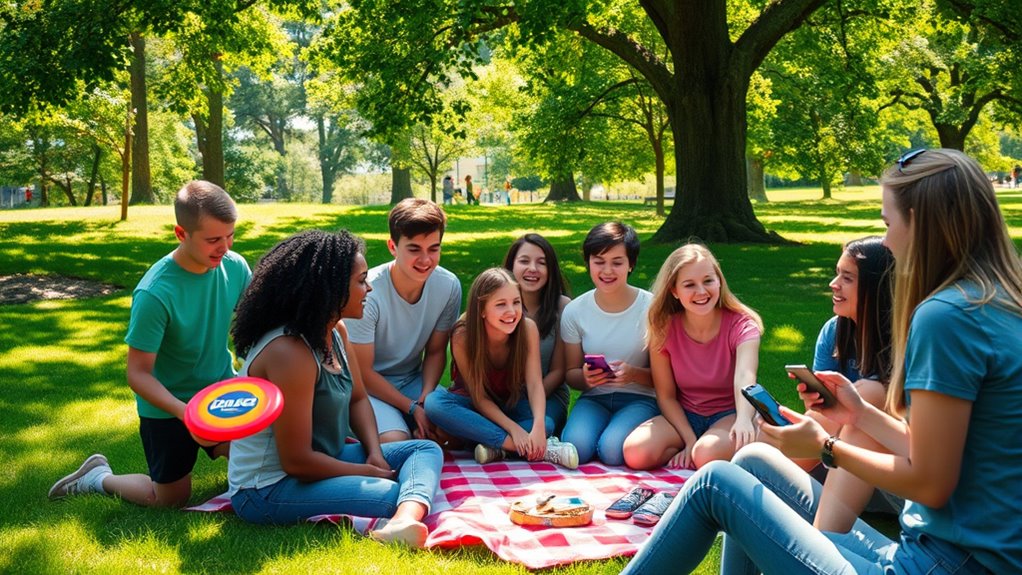If you’re a teen steering through social media, it’s crucial to strike a balance between online and offline life. With the average teen spending about 4.8 hours daily on social media, you might feel overwhelmed or anxious. Engaging in offline activities, like volunteering or spending time with friends, can boost your mental health and overall well-being. Also, having open conversations with your parents about social media use can create healthier habits. There’s more to discover about managing this balance effectively.
Key Takeaways
- Encourage teens to engage in offline activities, such as sports or hobbies, to promote social skills and reduce anxiety.
- Set clear boundaries for social media use to ensure a healthy balance between online and offline interactions.
- Facilitate open discussions about online experiences and challenges to strengthen family relationships and support mental health.
- Promote community involvement by encouraging volunteering, which enhances a sense of belonging and contributes to overall well-being.
- Emphasize the importance of regular physical activity as a way to improve mood and energy levels, complementing online engagement.
Prevalence of Social Media Use Among Teens

Almost all teens—97%—use the internet daily, making it a central part of their lives. You likely find yourself scrolling through YouTube, TikTok, Instagram, or Snapchat, as these platforms dominate your daily routine.
In fact, 95% of you use YouTube, with 71% visiting it daily. TikTok and Snapchat are also popular, with 67% and 59% of teens using them, respectively.
You probably spend around 4.8 hours on social media each day, with girls averaging 5.3 hours and boys 4.4 hours. As you engage with these platforms, you connect with friends and explore interests, reflecting your social needs. Notably, 51% of U.S. teenagers spend at least four hours daily on social media.
However, it’s essential to balance this online presence with offline activities to maintain a healthy lifestyle.
Effects of Social Media on Mental Health

As you navigate the world of social media, it’s important to recognize its potential impact on your mental health. Studies show that frequent use can lead to increased rates of depression, anxiety, and psychological distress. You might find yourself feeling isolated or anxious, especially when comparing your life to others online. Increased social media use can also lead to changes in brain areas related to emotions and learning, further complicating your emotional well-being.
Cyberbullying can exacerbate these feelings, leading to sadness and anxiety. Additionally, excessive social media use often disrupts sleep, leaving you drained and affecting your overall well-being. Body image issues may also arise from constant online comparisons. It’s essential to be aware of these risks and take steps to balance your online presence with offline activities, ensuring your mental health remains a priority.
Developmental Benefits of Social Media

While it’s easy to focus on the drawbacks of social media, it’s equally important to recognize its developmental benefits for teens.
Social media enhances your communication skills, letting you express yourself through various content forms. It exposes you to diverse cultures and global issues, fostering empathy and open-mindedness. Additionally, social media provides access to educational content that can help you stay updated on various fields and current events. Engaging with this content can also promote mindfulness practices, allowing you to enhance self-awareness and critical thinking. Furthermore, social media encourages participation in community events, which can foster social connections and support networks. Engaging with these platforms can also help you understand analytics for improving content strategy, which is beneficial for effective communication. Developing awareness of small mistakes in online interactions can also lead to improved relationships and resilience. Furthermore, participating in online discussions can help you develop critical thinking skills that are vital for successful engagement in both digital and real-world environments.
By sharing your creative talents, you explore your identity and boost self-esteem. You also gain access to valuable educational resources and insights into career paths.
Social media helps you connect with like-minded peers, building a sense of belonging. Engaging in creative challenges and community discussions hones your problem-solving skills and adaptability, preparing you for real-world interactions.
Embracing these benefits can enrich your personal growth and social development.
The Role of Parental Involvement

Parental involvement plays an essential role in steering through the complex landscape of social media for teens. With over 90% of teens using smartphones, it’s vital for you to engage actively in their online lives.
Discuss safety and proper use, as 94% of parents already do regarding content sharing. Setting clear rules about smartphone and social media use helps establish boundaries, and around 80% of parents implement these restrictions. Moreover, your understanding of social media influencers can significantly enhance your mediation strategies. Understanding the potential for emotional disconnection during extended online engagement is also crucial. Furthermore, being aware of the increased volatility in market dynamics can help you guide your teen in making informed decisions about their online interactions.
Active participation in social media empowers you to better mediate its influence on your teen. Balancing screen time with quality family interactions strengthens your relationship, while regular communication about online behavior guarantees they understand their digital responsibilities.
Ultimately, your guidance shapes their online experiences and safety.
Policy and Legislative Efforts

Given the urgent need to protect teens online, recent policy and legislative efforts are gaining momentum across the U.S.
The bipartisan Kids Off Social Media Act aims to prohibit social media access for users under 13 and restrict content algorithms for those under 17. It empowers the FTC and state attorneys general to enforce these provisions and mandates schools to limit social media on federally-funded networks.
In California, two bills are pushing for parental consent for algorithmic content and enhanced data privacy for minors, despite potential legal challenges.
These efforts reflect a growing awareness of social media’s mental health implications and a desire to create safer online environments for teens, balancing regulation with user rights. Additionally, the importance of establishing clear savings goals is vital for supporting teens’ financial literacy as they navigate the complexities of online interactions.
Finding a Balance: Online vs. Offline Activities

As policymakers work to create safer online environments for teens, it’s important to address the balance between their online and offline activities.
With 93% of teens using social media and nearly half online almost constantly, it’s imperative to encourage offline engagement. Spending excessive time online can strain face-to-face relationships and negatively impact mental health.
By setting clear boundaries around screen time, you can foster healthier habits. Encourage hobbies that spark your creativity and promote physical well-being, like sports or arts.
Encouraging Healthy Social Media Habits

While social media can be a powerful tool for connection, cultivating healthy habits around its use is essential for your well-being. Start by setting boundaries; avoid social media during meals or homework and limit screen time, especially before bed.
Regularly monitor your accounts to confirm you engage with positive content and unfollow anything that causes stress or unrealistic comparisons. Encourage yourself to follow accounts that inspire creativity or align with your interests. Additionally, consider understanding the importance of cybersecurity measures to protect your online presence from potential threats. To further enhance your well-being, incorporate air purifiers to improve the quality of your environment, which can positively impact your mood and focus. Engaging in outdoor activities can also help reduce the risk of tick-borne diseases, promoting a healthier lifestyle alongside your online interactions. Furthermore, participating in regular physical activity can enhance cardiovascular health, supporting your overall well-being as you balance online and offline life.
Engage in trends that promote physical activity and connection with others. Keep the lines of communication open with family and friends about your experiences online. Additionally, consider incorporating healthy habits such as drinking celery juice to boost your mood and energy levels throughout the day.
Community Engagement and Offline Connections

Engaging with your community and building offline connections can greatly enhance your overall well-being. In California, 64% of teens volunteered last year, showing that civic engagement is essential.
Teens who participate in these activities often report being in “very good” or “excellent” health. If you feel connected and believe you can make a difference, you’re part of the one-third of teens with high civic efficacy.
School-based service programs can help foster these habits, encouraging you to volunteer beyond school. While social media expands your network, it can’t replace face-to-face interactions.
Balancing online and offline activities is important, as offline engagement can alleviate anxiety and improve social skills, ultimately enriching your life and community.
Frequently Asked Questions
How Can Teens Protect Their Privacy on Social Media?
To protect your privacy on social media, start by adjusting your privacy settings to limit who can see your posts and interact with you.
Regularly review these settings to guarantee they meet your needs. Be cautious about sharing sensitive information and think before posting.
Use blocking and reporting features to manage unwanted interactions.
Finally, keep your online reputation in check by curating your content and deleting anything that doesn’t represent you well.
What Are the Signs of Social Media Addiction in Teens?
Imagine a teen named Alex, who spends hours scrolling through social media, neglecting homework and missing family dinners.
Signs of social media addiction include difficulty disconnecting, mood swings when offline, and neglecting responsibilities.
You might notice irritability or anxiety when you can’t check your notifications.
If your social interactions dwindle and you prioritize online validation over real-life connections, these could be red flags indicating an unhealthy relationship with social media.
How Does Social Media Influence Teen Relationships?
Social media influences your relationships by helping you connect quickly with others, but it can also complicate things.
You might find it easier to flirt online, yet excessive use can lead to misunderstandings and feelings of isolation.
You might also compare your life to others, which can create unrealistic expectations and jealousy.
Can Social Media Be Used for Educational Purposes?
Yes, social media can definitely be used for educational purposes.
You can access a wealth of information and engage in collaborative learning with peers through various platforms. It helps you develop essential digital skills and enhances your motivation by making learning more interactive.
However, you need to stay mindful of distractions and guarantee you’re using it wisely for academic growth. Balancing your use can lead to a more enriching educational experience.
What Strategies Help Teens Manage Online Bullying?
Traversing the digital forest, you’ve got to equip yourself with the right tools to fend off lurking shadows of online bullying.
First, don’t engage; silence can be your shield. Document each attack as evidence, then block those who harm you.
Reach out to trusted allies for support, and report serious threats to authorities.
Conclusion
In today’s fast-paced world, finding a balance between online and offline life is essential for teens. Remember, “all work and no play makes Jack a dull boy.” Embrace social media for its benefits, but don’t forget to nurture real-life connections. Encourage healthy habits and involve parents in the conversation. By fostering both online interactions and offline activities, you can create a well-rounded life that promotes mental well-being and personal growth. Stay engaged, both in-person and online!









